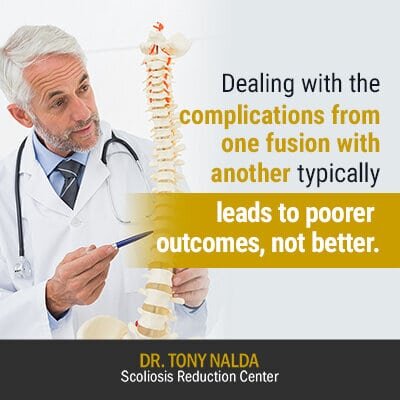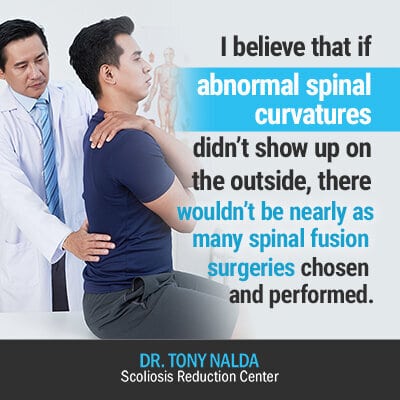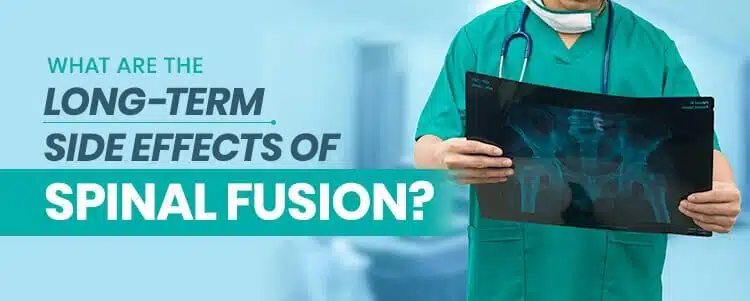While alternative forms of scoliosis treatment are steadily gaining in popularity, the traditional treatment path is still a dominant choice. As this approach still funnels patients towards spinal-fusion surgery, I can understand why people are interested in what its long-term effects are. Unfortunately, this question addresses one of the reasons I’m opposed to spinal-fusion because, truthfully, we really don’t know what the long-term effects are.
Weighing the pros and cons of undergoing an invasive procedure such as spinal-fusion surgery is not an easy process, especially if you’re the parent or caregiver of a child potentially facing the procedure. This is why I think it’s important that people considering the surgery fully understand the risks. First, let’s discuss the role of follow-ups in the context of spinal-fusion surgery.
The Role of Long-Term Follow-Ups
One of the issues I have with patients undergoing spinal-fusion surgery to treat their scoliosis is that we don’t actually know what the long-term effects will be 20, 30 years down the road.
There is no data or research that documents this long-term outcome, and this is scary because it’s a major, costly, and invasive operation. This is particularly disturbing considering who the majority of scoliosis patients are that the surgery is being performed on: young children and adolescents.
When follow-ups are done to scoliosis patients who have undergone spinal-fusion surgery, they are mainy 2- or 5-year follow-ups, and even within that range, the majority of follow-ups are only two years later.
At these 2-year follow-ups, often the assessment is, “Okay, it’s two years down the road, and everything’s great. Off you go.”
At two years post surgery, most of the patients are still very young, with many still having growth and development to go through, and that surgery can affect that growth and development.
As far as I know, there’s no data saying, “We did 100 spinal fusions on 12 years olds, and this is the outcome for them now that they’re 20, 30, 40, and 50 years old.”
Another big concern I have, and it’s a concern with any form of surgery that puts foreign hardware into the body, is hardware longevity and failure.
Hardware Longevity and Failure
Any medical procedure that depends upon installing foreign and unnatural hardware into the body comes with additional risks and related questions: What type of material is being used? How long will the hardware last? Can the hardware break or malfunction in any way? What happens if the hardware does fail?
The bottom line is that every hardware has a lifespan, and we know that there are limitations to how long that hardware will remain in peak condition. The issue is we don’t always know how long that lifespan is, nor do we fully understand the multitude of factors that can influence its longevity.
Not only is there the lifespan of the hardware that’s a concern; the hardware can also fail. Spinal fusion involves the use of a variety of hardware such as rods, screws,
and sometimes hooks and wires. Potential failure could include a screw coming loose, a rod snapping, or natural wear and tear that accompanies aging.
As I mentioned earlier, the majority of scoliosis patients undergoing spinal-fusion surgery are adolescents between the ages of 10 and 18; this is because approximately 80 percent of scoliosis patients are cases of adolescent idiopathic scoliosis that fall into that age group.
If we think of 12 year olds undergoing the surgery, the fact is that that hardware is going to have to last a long time if we want it to last for the lifetime of the patient, and is that expectation realistic?
What is very likely is that, at some point, that 12 year old is going to need some type of revision. There are going to be future problems; we just don’t know exactly when or how bad they are going to be.

The scariest part of this unknown is that once spinal-fusion surgery has been performed, if things go wrong, there really is only one treatment option, and in most cases, that’s additional surgeries.
Dealing with the complications from one fusion with another typically leads to poorer outcomes, not better.
Basically, it’s a big flip of the coin because we simply don’t know or fully understand what the long-term effects of spinal-fusion surgery on scoliosis patients are.
Why do People Opt for Spinal Fusion?
I’m sure, right around now, you’re asking yourself why, if there is so little data on its long-term effects, spinal-fusion surgery is still so readily performed on scoliosis patients; there are a few different reasons for this.
Long-term side effects of spinal fusion, such as those following an anterior spinal fusion or L4-L5 fusion surgery, can impact life expectancy after spinal fusion by potentially leading to adjacent segment degeneration, chronic pain, and reduced mobility.
While scoliosis surgery can effectively treat the condition, individuals may wonder about the long-term side effects, such as whether scoliosis surgery can kill you or the potential scoliosis surgery side effects, as they consider their treatment options.
The Dominance of the Traditional Approach
Firstly, for many years, the traditional approach was the only choice around, and while alternative forms of treatment, such as my chiropractic approach, have gained respect and popularity over the years, the traditional approach is still firmly entrenched.
Scoliosis, as the leading spinal deformity in the United States, has a number of debates that circle around it from causation to treatment. As the majority of cases are classed as ‘idiopathic’, this means we can’t isolate one single cause to explain the ‘why’ or ‘how’ of its development.
In light of the complexity and mystery that still surrounds the condition, it doesn’t seem unreasonable to me that there are a lot of unknowns surrounding one of its main treatment approaches: spinal-fusion surgery.
This is one of the reasons I became a scoliosis specialist and opened up the Scoliosis Reduction Center®. I wanted to make a real difference in the lives of the millions of people living with scoliosis. I wanted to explore different forms of treatment that are less invasive and risky and deliver them as an accessible, effective, and proactive form of treatment. It’s also why I wrote Scoliosis Hope: to educate the public on the risks associated with spinal-fusion surgery, empower them with information, and give them another option.
There are additional reasons patients opt for spinal fusion, and the number one reason is often cosmetic.
Cosmetic Reasons
While scoliosis can develop at any age, as discussed, it’s most common in adolescents. Thinking of the adolescent mind and moving through those tumultuous teenage years for a minute, I’m sure you’ll agree that appearances are pretty important.
Most adolescents and teenagers just want to fit in. They want to blend with their classmates and peers; they certainly don’t want to stand out because a spinal deformity has changed their posture, how they walk, or how they look in a bathing suit.
While many people assume that spinal-fusion surgery will make them look different, this is not always the case, and many patients are disappointed that it doesn’t produce the cosmetic change they were hoping for.

Especially in cases of adolescent scoliosis, pain is rarely an issue, nor are the complications associated with scoliosis in adults, so pain management and functional issues aren’t often the number-one reason adolescents and teenagers opt for the surgery.
I believe that if abnormal spinal curvatures didn’t show up on the outside, there wouldn’t be nearly as many spinal fusion surgeries chosen and performed.
This is not to say cosmetic is the only reason, but it’s often the inspiration behind the choice.
Spinal Fusion and Spinal Misalignment
From a medical treatment perspective, the big issue that scoliosis causes is spinal misalignment, meaning the spine is no longer aligned as it should be. The spine is curved the way it is for a number of reasons, and when the spine loses those healthy curves due to a spinal deformity like scoliosis, those healthy curves are replaced by bad curves.
In terms of simply straightening a crooked spine, using rods and screws to hold a spine can accomplish that, but at what cost? A spine that’s simply held in position is not the same as working to naturally mobilize, strengthen, and support the spine so it can hold itself in a corrective position; those are two very different things.
People think that the rods holding the spine in position means successful treatment, but the cost is in potential complications, risks, and spinal flexibility.
What we do at the Center is very different. We spend the time and engage with our patients to work hard and customize a treatment plan. Our goal of treatment is to achieve a curvature reduction that’s sustainable and avoids all the risks and complications associated with spinal-fusion surgery.
Our treatment approach involves moving the spine through a series of disciplines: scoliosis-specific exercise, bracing, therapy, and chiropractic adjustments. We opt for a structural change by correcting the spinal misalignment, rather than simply holding the spine in place by artificial means.
Long-term side effects of spinal fusion, particularly in cases involving the lumbar spine, have been a subject of concern for individuals undergoing this complex spine surgery. While spinal fusion can provide relief from certain conditions, such as chronic back pain and instability, it can also lead to potential complications like adjacent segment degeneration. This condition occurs when the segments of the spine adjacent to the fusion site experience increased stress over time, potentially requiring further treatment.
Patients often wonder about their life expectancy after spinal fusion, and while the surgery can improve quality of life, it’s essential to weigh the benefits against the risks and potential long-term consequences. Patients and healthcare providers should engage in thorough discussions to make informed decisions about the necessity and timing of posterior spinal fusion procedures, considering both immediate relief and long-term spinal health.
As we’ve spent a lot of time addressing the issue of spinal fusion in adolescents and the motivation behind it, let’s touch on adult scoliosis and spinal-fusion surgery.
Adult Scoliosis and Spinal-Fusion Surgery
Adults experience scoliosis very differently than adolescents, which is why the motivation behind getting the surgery can also be very different.
In adults, scoliosis can cause a lot of pain, and this is the number-one reason adults with scoliosis opt for spinal fusion as their treatment path. Severe scoliosis in adults, if left untreated, can also produce a number of associated complications such as lung impairment and cardiac issues.
The number-two reason is postural collapse, and this can take the form of a kyphosis collapse (side collapse), a lateral collapse, or a combination of the two.
It’s mainly when the issue of pain or postural collapse emerges that adults seek out treatment: surgical or alternative.
Of course, when an adult patient opts for spinal-fusion surgery, the hardware doesn’t need to last as long as it would in a 12-year-old patient, but it still needs to last well past the timeframe of the surgery’s known effects. Also, an invasive surgery becomes more risky and the number of potential complications increase exponentially the older a person gets.
The long-term side effects of spinal fusion surgery can vary depending on factors such as the patient’s age and the reason for the surgery. Elderly patients who have undergone spine surgery, particularly for conditions like spinal stenosis or lumbar spinal stenosis, may experience changes in their mobility and overall quality of life.
While spinal fusion can provide relief from pain and improve spinal stability, it’s important to consider potential long-term impacts, including any effects on life expectancy after spinal fusion. Consulting with healthcare professionals can help individuals make informed decisions about their treatment and understand the potential outcomes of lumbar spine surgery.
Spinal fusion surgery can be an effective treatment for conditions like scoliosis, it may come with long-term side effects. Some individuals may experience kyphosis after spinal fusion surgery, which can affect their posture and mobility. Understanding the potential permanent restrictions after spinal fusion and what to expect during the spinal fusion recovery process is essential for patients considering this procedure.
Exploring the long-term side effects of spinal fusion, individuals with scoliosis may be curious about the impact on their health, including concerns about mortality and the use of a Harrington rod for scoliosis.
When it comes to spinal-fusion surgery and kyphosis surgery in adults, the question changes from, “Will there be complications?” to “How many complications will there be, and how severe will they be?”
Conclusion
While we know some of the short-term effects of spinal-fusion surgery on scoliosis patients, when it comes to how the surgery impacts their bodies and lives 20, 30 years down the road, there just isn’t the research to clearly provide an answer.
While surgeons have the best interests of their patients at heart, any procedure comes with risks. As the spine works in tandem with the brain to form the body’s central nervous system, any condition or surgery that affects its function can impact the body in multiple ways.
If you or someone you love is facing the choice of whether to undergo spinal-fusion surgery as a scoliosis treatment option, I urge you to weigh the risks versus reward and first try other more natural treatment approaches.
I believe that spinal-fusion surgery should always be a last resort, after all other options have been explored and exhausted.
Here at the Scoliosis Reduction Center®, we have had hugely successful results treating patients with a more modern and dynamic approach that doesn’t carry the risks, complications, and unknowns associated with spinal-fusion surgery.





